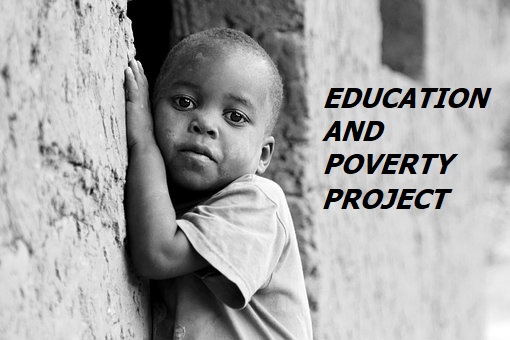Exploring the relationship between Education and Poverty
Education and poverty are two interconnected issues that have been the focus of attention for decades. While education is considered to be a fundamental right and a key factor for socioeconomic development, poverty remains a major obstacle for many individuals and communities around the world. Access to education is often limited for those living in poverty, and without adequate education, breaking the cycle of poverty becomes more challenging.
The impact of poverty on education is complex and multifaceted, affecting not only the individual but also their family and community. In this context, it is essential to explore the relationship between education and poverty and to examine the policies and programs that can help address the issue. Through this article today we will investigate the impact of poverty on education, the challenges faced by those living in poverty in accessing education, and the role of education in alleviating poverty.
Is Education Responsible For Poverty?
Education itself is not responsible for poverty, but the lack of access to education and the quality of education can contribute to poverty.
People living in poverty often lack access to quality education.
This further lead to a lack of skills and knowledge necessary to obtain well-paying jobs, start businesses, or otherwise improve their economic
situation.
Additionally, the cost of education can be a significant barrier for people living in poverty, which can prevent them from pursuing higher
education or even completing basic education.
Furthermore, education is essential for the development of critical thinking, problem-solving, and decision-making skills.
These skills are important for making informed decisions about personal finances and investments.
Without these skills, people may make poor financial decisions, leading to financial instability and poverty.
In summary, education can be a key factor in breaking the cycle of poverty, but a lack of access to quality education can contribute to poverty
and perpetuate its cycle.
Is Poverty Responsible For Poor Education?
Yes, poverty can be responsible for poor education.
Children from low-income families are more likely to face educational barriers.
They have limited access to quality schools, lack resources, and have inadequate school facilities.
In addition, poverty often results in lower levels of parental education, which can limit the ability of parents to support their children’s
education.
Furthermore, poverty can also impact the quality of education provided in schools serving low-income communities.
These schools may have less funding, less experienced teachers, and fewer resources to provide quality education to their students.
This can result in a lack of opportunities and support for students, limiting their ability to succeed academically and breaking the cycle of
poverty.
Why Poor People Do Not Want To Invest In Education?
There are various reasons why some poor people may not invest in the education of their children. Here are five possible reasons:
Financial constraints
One of the primary reasons why poor people may not invest in the education of their children is due to financial constraints.
They may not have the financial resources to afford school fees, uniforms, books, transportation, and other associated costs of education.
Lack of awareness
Poor people may not be aware of the importance of education and its impact on their children’s future.
They may not understand the long-term benefits of investing in education, such as better job opportunities and higher earning potential.
Limited access to quality education
: Poor people may live in areas where there are no quality schools available.
They may not have access to resources, such as textbooks or qualified teachers.
This can make it difficult for them to invest in their children’s education.
Social and cultural factors
In some cases, social and cultural factors may discourage poor families from investing in their children’s education.
For example, girls may be expected to prioritize household chores and marriage over education.
Immediate needs take priority
Poor people may have to prioritize immediate needs such as food, clothing, and shelter over-investing in their children’s education.
They may view education as a long-term investment that may not bring immediate benefits.
while the need for basic necessities is more urgent.
It is important to note that these are not the only reasons why poor people may not invest in their children’s education.
the reasons can vary depending on the individual circumstances and cultural contexts
Policies and Programs that can help eradicate Poverty
Literacy programs for low-income families
This project can focus on designing and implementing literacy programs that cater to the needs of low-income families.
It can involve developing reading materials that are affordable and accessible to families living in poverty and partnering with community
organizations to provide literacy support and resources.
Impact of illiteracy on poverty
This project can examine the relationship between illiteracy and poverty.
Moreover, the purpose is to explore how low literacy levels contribute to the cycle of poverty.
It can involve analyzing data on literacy rates and poverty levels.
Furthermore, conducting case studies to identify the challenges faced by individuals who lack basic literacy skills.
Promoting literacy through entrepreneurship
This project can focus on promoting literacy by providing entrepreneurship opportunities to individuals living in poverty.
It can involve setting up small businesses that offer basic literacy training and education.
Moreover, it can be a part of their services and work with local organizations to provide funding and support.
Government Schemes To Promote Education In India
Sarva Shiksha Abhiyan (SSA)
Sarva Shiksha Abhiyan was launched in 2001.
It is a flagship program that aims to provide free and compulsory education to all children in the age group of 6 to 14 years.
The program focuses on the universalization of elementary education, infrastructure development, and teacher recruitment and training.
Mid-Day Meal Scheme
The mid-Day Meal scheme was launched in 1995.
The aim was to provide free and nutritious meals to school-going children.
The program covers primary and upper primary schools.
Moreover, it aims to improve the nutritional status of children and encourage them to attend school regularly.
Rashtriya Madhyamik Shiksha Abhiyan (RMSA)
Launched in 2009, RMSA aims to increase the enrollment of children in secondary education.
Especially among girls and children from disadvantaged backgrounds.
However, the program focuses on providing infrastructure support, teacher training, and vocational education.
National Scholarship Portal
This National Scholarship Scheme was launched in 2015 to provide scholarships.
These scholarships were mainly for students from economically weaker sections (EWS) and other disadvantaged communities.
The portal provides a platform for students to apply for scholarships offered by different government agencies.
It aims to increase the accessibility of financial support for education.
Beti Bachao, Beti Padhao Yojana
Beti Bachao, Beti Padhao Yojana was launched in 2015.
This scheme aims to improve the status of the girl child and promote education among them.
The program focuses on addressing issues such as gender bias, female foeticide, and low female literacy rates.
It provides incentives for the education of girls, such as scholarships and free bicycles.
Moreover, it aims to create a positive social environment for girls to pursue education.
Reasons For Poor Education In African Countries
There are several reasons for poor education in African countries, including:
Poverty
Poverty is a significant barrier to education in many African countries.
Families living in poverty may struggle to afford basic necessities such as food and shelter.
Moreover, they cannot afford education-related expenses such as school fees, uniforms, and textbooks.
This can make it difficult for children to attend school regularly and may lead to high dropout rates.
Lack of infrastructure
Many African countries lack adequate school infrastructure, including classrooms, libraries, and textbooks.
This can result in overcrowded classrooms, limited access to learning materials, and a lack of qualified teachers.
In some cases, schools may be located far away from communities, making it difficult for children to attend regularly.
Conflict and instability
Armed conflict, political instability, and civil unrest can have a significant impact on education in African countries.
Schools may be damaged or destroyed during conflicts.
Teachers and students may be forced to flee their homes, leading to disruptions in education.
Children who are displaced or who have been affected by conflict may also struggle with mental health issues.
All these factors impact their ability to learn.
Cultural attitudes
Cultural attitudes toward education can also be a barrier to learning in some African countries.
In some cases, children are expected to work or help with household chores.
This makes it difficult for them to attend school regularly.
Girls, in particular, may be discouraged from pursuing education due to cultural norms and gender-based discrimination.
Inadequate funding
Many African countries lack adequate funding for education.
This can lead to a shortage of teachers, inadequate pay for teachers, and limited resources for schools.
It can also result in a lack of investment in teacher training and professional development.
Therefore, the reasons for poor education in African countries are complex and multifaceted.
Addressing these issues will require a comprehensive approach.
Reasons For Poor Education In Islamic Countries
There are several reasons for poor education in Islamic countries, including:
Lack of investment in education
Some Islamic countries may not prioritize investment in education, either due to limited financial resources or other priorities.
This can lead to a shortage of educational facilities, qualified teachers, and materials.
Cultural and religious attitudes
In some Islamic countries, cultural or religious attitudes may discourage girls from attending school.
There may be a preference for boys’ education.
This can lead to gender disparities in education, with fewer girls attending school than boys.
Political instability and conflict
Ongoing political instability and conflict can disrupt the education system in Islamic countries.
Displacement and migration can cause interruptions in children’s education and make it challenging for children to attend school regularly.
Poverty
Poverty is a significant barrier to education in many Islamic countries.
Poor families may not be able to afford the costs associated with attending school, such as uniforms, transportation, and supplies.
This can lead to lower enrollment and higher dropout rates.
Lack of teacher training and support
In some Islamic countries, teachers may not receive adequate training or support to deliver quality education.
Teachers may be underpaid, overworked, or underqualified, which can result in lower-quality education for students.
Ideological extremism
In some Islamic countries, extremist groups may target schools and teachers, leading to disruptions in education and creating an unsafe
environment for students and teachers.
Therefore, the reasons for poor education in Islamic countries are complex and multifaceted.
Addressing these issues will require a comprehensive approach and combatting ideological extremism.
Solutions To Eliminate Poverty Through Education?
There are several solutions to eliminate poverty through education, including:
Increasing access to education
Governments and other organizations can work to increase access to education for those living in poverty.
This could involve building new schools, providing scholarships or financial aid, or offering distance learning programs.
Improving the quality of education
Providing quality education is essential to ensure that those who receive it can make the most of their education.
This can involve improving teacher training, upgrading school infrastructure, and providing necessary learning materials and resources.
Addressing social and cultural barriers
In some cases, social and cultural attitudes can be barriers to education.
Governments and organizations can work to address these attitudes and promote education as a valuable tool for reducing poverty.
Offering vocational training
Vocational training programs can provide individuals with the skills and knowledge they need to secure good-paying jobs and lift themselves
out of poverty.
Encouraging entrepreneurship
Providing support for entrepreneurs through education and training can enable individuals to start businesses and create job opportunities
for themselves and others.
Collaboration between the government, NGOs, and the private sector
Collaboration between different organizations and sectors can create a more comprehensive and effective approach to eliminating poverty
through education.
Therefore, education can play a significant role in reducing poverty.
By providing individuals with the skills and knowledge they need to secure better-paying jobs.
Education can enable individuals and communities to break the cycle of poverty and create a more prosperous future.
Impact of education and poverty on economic development
Education and poverty can have a significant impact on economic development.
On one hand, education is essential to economic growth and development.
A well-educated workforce can increase productivity, innovation, and technological advancements, which can lead to higher levels of
economic growth.
Education can also contribute to a more stable and well-functioning society, with more informed citizens and better political institutions.
On the other hand, poverty can hinder economic development.
Individuals living in poverty often lack the resources and opportunities needed to participate fully in the economy.
This can further lead to reduced productivity and economic growth.
Moreover, poverty can also create social and economic instability, leading to challenges in attracting investment and doing business.
Investing in education can be an effective way to reduce poverty and promote economic development.
Education can help individuals develop the skills and knowledge they need to secure better-paying jobs, start businesses, and contribute to
the economy.
By reducing poverty and increasing economic participation, education can drive economic growth and development.
Conclusion On Education and Poverty
In conclusion, education is a critical tool for reducing poverty.
Lack of access to quality education is a significant barrier to social and economic mobility.
particularly in low-income and developing countries.
Education can empower individuals with the skills and knowledge they need to secure.
Addressing barriers to education, such as poverty, cultural attitudes, and political instability, is crucial to ensuring that all individuals have the
opportunity to benefit from education.
Therefore, Investing in education can also have broader benefits, including improved health outcomes, reduced inequality, and increased
economic growth. In short, education is an essential pathway out of poverty and a key driver of development and progress.





0 Comments